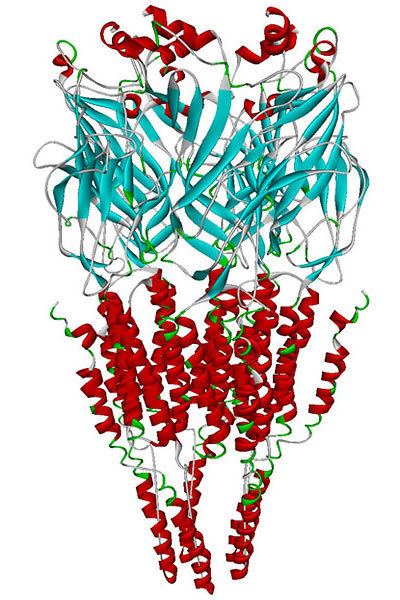The alpha-7 nicotinic receptor, also known as the α7 receptor, is a type of nicotinic acetylcholine receptor implicated in long term memory, consisting entirely of α7 subunits. As with other nicotinic acetylcholine receptors, functional α7 receptors are pentameric [i.e., (α7)5 stoichiometry].
It is located in the brain, spleen, and lymphocytes of lymph nodes where activation yields post- and presynaptic excitation, mainly by increased Ca2+ permeability.
Recent work has demonstrated a potential role in reducing inflammatory neurotoxicity in stroke, myocardial infarction, sepsis, and alzheimers disease.
An α7 nicotinic agonist appears to have positive effects on neurocognition in persons with schizophrenia.
Both α4β2 and α7 nicotinic receptors appear to be critical for memory, working memory, learning, and attention.
α7-nicotinic receptors also appear to be involved in cancer progression. They have been shown to mediate cancer cell proliferation and metastasis. α7 receptors are also involved in angiogenic activity, and have anti-apoptotic effects.
(+)-N-(1-azabicyclo[2.2.2]oct-3-yl)benzo[b]furan- 2-carboxamide: potent and highly subtype-selectiveA-582941: partial agonist; activates ERK1/2 and CREB phosphorylation; enhances cognitive performanceAR-R17779: full agonist, nootropicAmyloid beta: neurotoxic marker of Alzheimer's disease TC-1698: subtype-selective; neuroprotective effects via activation of the JAK2/PI-3K cascade, neutralized by angiotensin II AT(2) receptor activationTC-5619 - partial agonist, in development for treatment of schizophreniaEVP-6124 - partial agonist with nootropic properties, in development for treatment of schizophrenia and Alzheimer's disease GTS-21 - partial agonist, in development for treatment of schizophrenia and/or Alzheimer's diseasePHA-543,613 - selective and potent agonist with nootropic properties PNU-282,987 - selective and potent agonist, but may cause long QT syndromePHA-709829: potent and subtype-selective; robust in vivo efficacy in a rat auditory sensory gating modelAnalogues: improved hERG safety profile over PNU-282,987SSR-180,711: partial agonistTropisetron: subtype-selective partial agonist; 5-HT3 receptor antagonistWAY-317,538 - selective potent full agonist with nootropic and neuroprotective propertiesAnabasineAcetylcholineNicotineCholine ICH-3: subtype-selective partial agonist;At least two types of positive allosteric modulators (PAMs) can be distinguished.
PNU-120,596NS-1738: marginal effects on α7 desensitization kinetics; modestly brain-penetrantAVL-3288: unlike the above PAMs, AVL-3288 does not affect α7 desensitization kinetics, and is readily brain penetrant. Improves cognitive behavior in animal models In clinical development for cognitive deficits in schizophrenia.A-867744IvermectinGalantamineNefiracetamIt is found that anandamide and ethanol cause an additive inhibition on the function of α7-receptor by interacting with distinct regions of the receptor. Although ethanol inhibition of the α7-receptor is likely to involve the N-terminal region of the receptor, the site of action for anandamide is located in the transmembrane and carboxyl-terminal domains of the receptors.
Anandamideα-Bungarotoxinα-Conotoxin ArIB[V11L,V16D]: potent and highly subtype-selective; slowly reversibleBupropion (very weakly)DehydronorketamineEthanolHydroxybupropion (very weakly)HydroxynorketamineKetamineKynurenic acidMemantineLobelineMethyllycaconitine NorketamineQuinolizidine (–)-1-epi-207I: α7 subtype preferring blocker
